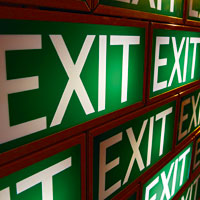Living artwork, creations that come to life and experiential installations will be on show for the remarkable Kinetica Art Fair 2012; the UK’s only art fair dedicated to kinetic, robotic, sound, light and time-based art. The vibrant event, now in its fourth year, is also one of the major opportunities to see and buy kinetic art in the world, where leading artists and galleries from around the globe will exhibit work that blends science, technology, nature and new media to create astonishing and often breathtaking creations.
With the increasing advancement and development of a scientific and technological culture, it is only natural that many contemporary artists have crossed the plateau from ‘fine art disciplines’ into ‘multi-disciplinary new media’ with artworks that utilise and warp technology itself, to explore, nurture and comment on our evolutionary processes. Emerging from a cultural need to showcase and provide a platform for contemporary artists working in these new media, as well as to re-present significant pieces from our recent past, Kinetica focuses on work that essentially makes suggestions and contributions towards human evolution including alternative insight and reaction to scientific and universal exploration.
Work from Kinetica Art Fair’s new artists scheme, Oxygen, will also be on sale. Oxygen provides a new showcase for a diverse range of work from emerging artists from across contemporary kinetic, electronic and new media art and offers their work for sale.
Time and transformation
Time, transformation and energy, is the theme for this year’s exhibition and events programme. The year 2012 is an auspicious year in the Mayan calendar that marks 21 December 2012 as the end of a 5,000 year old era and a time of change. Time, transformation and energy are tenants of kinetic art. They are also fundamental parts of human life and existence. The ancient, yet supremely accurate Maya had a distinct relationship with the solar system. The connections between space, science, nature, astrology and the artistic interpretations of time, transformation and energy will be explored throughout the feature exhibition.
Tickets start at £12 and work on sale ranges in price from £40 – £35,000 – so there’s plenty for all wallet sizes. A full programme of talks, groundbreaking performances and special events will also take place.
About Kinetic Art
Kinetic art is art that has a life of its own. It was pioneered by world-famous artists including Maholy Nagy, Jean Tinguely, Marcel Duchamp and Alexander Calder during the 1900s. The earliest attempt to incorporate kinetics in an artwork was Moholy-Nagy’s Space-Light Modulator, a sculpture producing moving shadows made at the Bauhaus between 1922 and 1930 and certain Constructivist works including Marcel Duchamp’s Rotary Glass Plate and Rotary Demisphere (Precision Optics), and Alexander Calder’s motorised sculptures from the 1930s.
The expression kinetic art was used from the mid-1950s onward. It referred to an international trend followed by artists such as Soto, Takis, Agam and Schoffer. Some Kinetic artists also worked in the field of Op Art. Their works were influenced by a modernist aesthetic and could be made with contemporary materials (e.g., aluminium, plastic, neon). Most kinetic works were moving geometric compositions. In Italy artists belonging to Gruppo N, founded in Padua in 1959 (including Biasi, Costa and Massironi, among others), carried out experiments with light, projections and reflections associated with movement, time and space.
The members of the French group GRAV, which included Le Parc, Morellet and Sobrino and was established in the 1960s in Paris, created optical and kinetic environments that disturbed and interfered with meanings and relations to space.
The term kineticism broadened the concept of Kinetic Art to all artistic works involving movement. It applies to all those artists today who work with any kind of movement in relation to space, time, energy and matter.
Modern contemporary kinetic and electronic artworks utilise and warp technology itself, to explore, nurture and comment on our evolutionary processes and challenge scientific and universal exploration.
About the venue
The 2012 Kinetica Art Fair will be held at Ambika P3, a magnificent 14,000sq ft triple height subterranean space in central London, converted from the vast former concrete construction hall for the University of Westminster’s School of Engineering. Built in the 1960s, its dramatic and impressive scale and many retained industrial features offer an unprecedented environment for the exhibition of multi-disciplinary and performative art on show. It is conveniently located below ground opposite Baker Street Tube Station on Marylebone Road.
For more information about tickets, purchases and the exhibitors, please visit:
www.kinetica-museum.org





